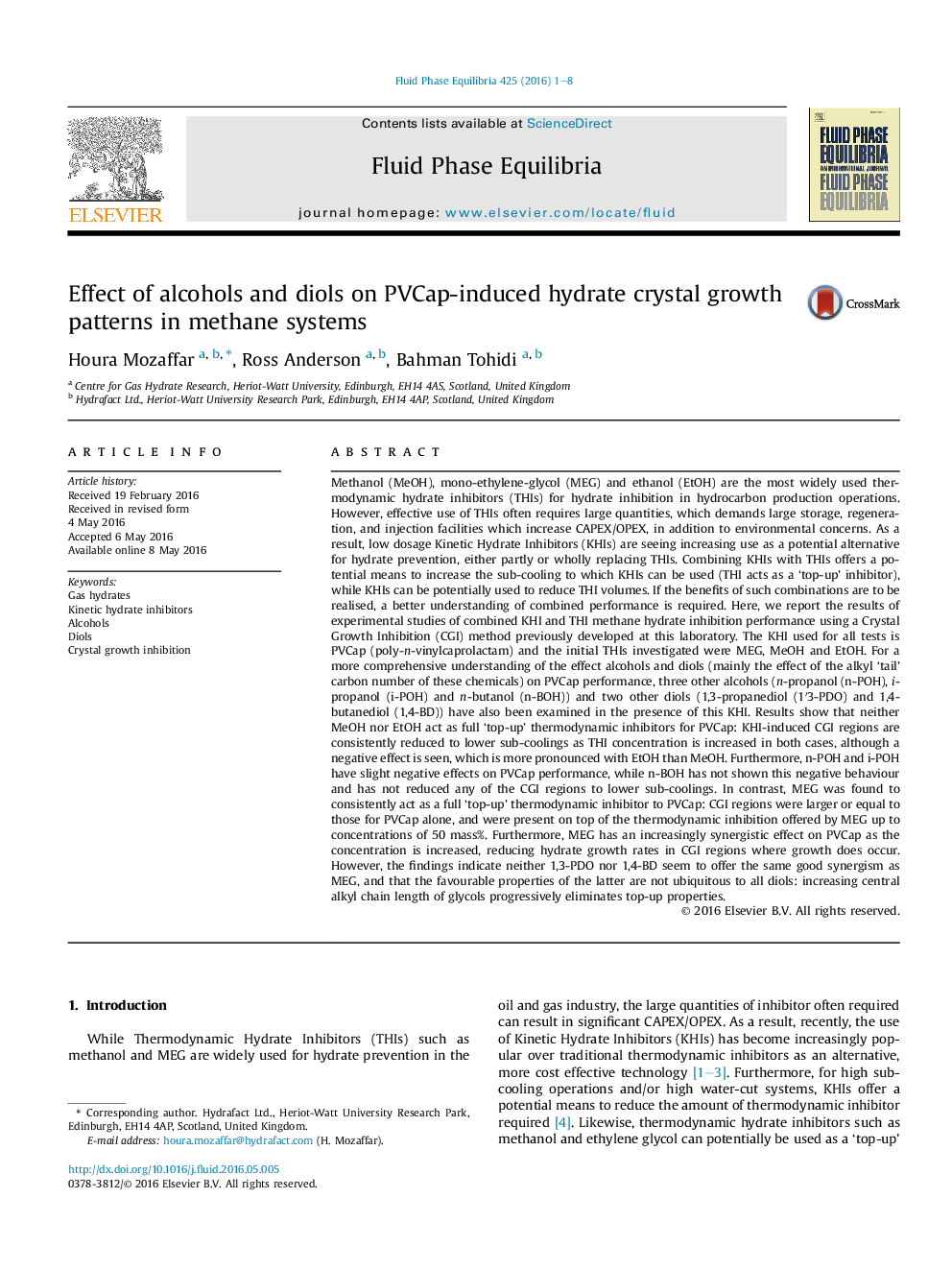| کد مقاله | کد نشریه | سال انتشار | مقاله انگلیسی | نسخه تمام متن |
|---|---|---|---|---|
| 201077 | 460533 | 2016 | 8 صفحه PDF | دانلود رایگان |
• None of the tested alcohols act as a ‘top-up’ thermodynamic inhibitor with PVCap.
• Alcohol plus PVCap offers far better inhibition than any of the alcohols alone.
• Alcohol molecular weight alone is not the controlling factor on its effect on PVCap.
• MEG is a full ‘top-up’ thermodynamic inhibitor for PVCap at tested concentrations.
• Increasing diols central alkyl chain length gradually eliminates top-up properties.
Methanol (MeOH), mono-ethylene-glycol (MEG) and ethanol (EtOH) are the most widely used thermodynamic hydrate inhibitors (THIs) for hydrate inhibition in hydrocarbon production operations. However, effective use of THIs often requires large quantities, which demands large storage, regeneration, and injection facilities which increase CAPEX/OPEX, in addition to environmental concerns. As a result, low dosage Kinetic Hydrate Inhibitors (KHIs) are seeing increasing use as a potential alternative for hydrate prevention, either partly or wholly replacing THIs. Combining KHIs with THIs offers a potential means to increase the sub-cooling to which KHIs can be used (THI acts as a ‘top-up’ inhibitor), while KHIs can be potentially used to reduce THI volumes. If the benefits of such combinations are to be realised, a better understanding of combined performance is required. Here, we report the results of experimental studies of combined KHI and THI methane hydrate inhibition performance using a Crystal Growth Inhibition (CGI) method previously developed at this laboratory. The KHI used for all tests is PVCap (poly-n-vinylcaprolactam) and the initial THIs investigated were MEG, MeOH and EtOH. For a more comprehensive understanding of the effect alcohols and diols (mainly the effect of the alkyl ‘tail’ carbon number of these chemicals) on PVCap performance, three other alcohols (n-propanol (n-POH), i-propanol (i-POH) and n-butanol (n-BOH)) and two other diols (1,3-propanediol (1′3-PDO) and 1,4-butanediol (1,4-BD)) have also been examined in the presence of this KHI. Results show that neither MeOH nor EtOH act as full ‘top-up’ thermodynamic inhibitors for PVCap: KHI-induced CGI regions are consistently reduced to lower sub-coolings as THI concentration is increased in both cases, although a negative effect is seen, which is more pronounced with EtOH than MeOH. Furthermore, n-POH and i-POH have slight negative effects on PVCap performance, while n-BOH has not shown this negative behaviour and has not reduced any of the CGI regions to lower sub-coolings. In contrast, MEG was found to consistently act as a full ‘top-up’ thermodynamic inhibitor to PVCap: CGI regions were larger or equal to those for PVCap alone, and were present on top of the thermodynamic inhibition offered by MEG up to concentrations of 50 mass%. Furthermore, MEG has an increasingly synergistic effect on PVCap as the concentration is increased, reducing hydrate growth rates in CGI regions where growth does occur. However, the findings indicate neither 1,3-PDO nor 1,4-BD seem to offer the same good synergism as MEG, and that the favourable properties of the latter are not ubiquitous to all diols: increasing central alkyl chain length of glycols progressively eliminates top-up properties.
Journal: Fluid Phase Equilibria - Volume 425, 15 October 2016, Pages 1–8
